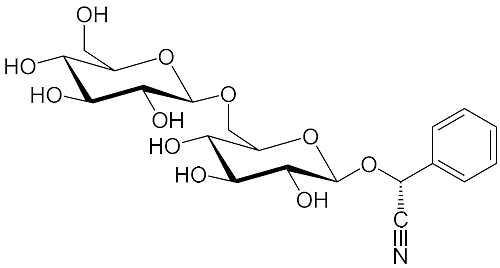 |

Amygdalin
“the slickest, most sophisticated,
and certainly the most
remunerative cancer quack
promotion in medical history”

Paul May
Bristol University

Molecule of the Month November 2017
Also available: JSMol version.

|
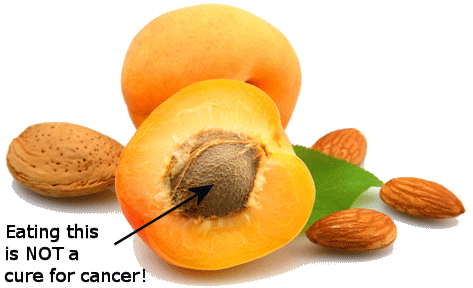 |
Isn’t the amygdala part of the brain?
Yes, the amygdala are two almond-shaped protrusions in the brain used in memory and decision making.
So amygdalin comes from, what…minced-up brains?
No, it is found in many plants, but it got its name from almonds (the Greek for which is amygdale), after it was first isolated from bitter almond seeds in 1830 by two French chemists Pierre Jean Robiquet (famous for his work identifying amino acids) and Antoine Charlard.
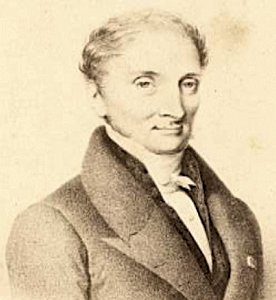 |
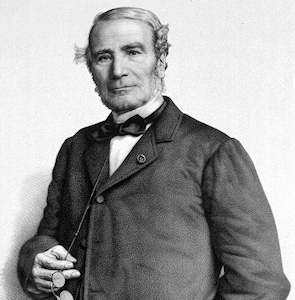 |
| A portrait of Pierre Jean Robiquet |
Antoine Charlard |
Ok, it’s found in almonds then?
Yes, in the kernels of bitter almonds, which are the wild variey of almonds. (The variety you buy in the shops are called 'sweet almonds' which have been specially bred to have 50 times less cynanide in them and so are harmless). But amygdalin is also found in the kernels or seeds of many plants and fruits, such as apricots, apples, peaches and plums, and some species of rose hips.
You said those seeds contain cyanide?
Yes, but not as free cyanide. That’s where amygdalin comes in. When eaten, amygdalin is hydrolysed by various enzymes in the intestine to L-mandelonitrile (a.k.a. laetrile), and then hydrolysed further to benzaldehyde, glucuronic acid plus hydrogen cyanide. This means that apricot kernels (and the other seeds mentioned above), can causes potentially lethal cyanide poisoning if consumed in sufficient amounts.
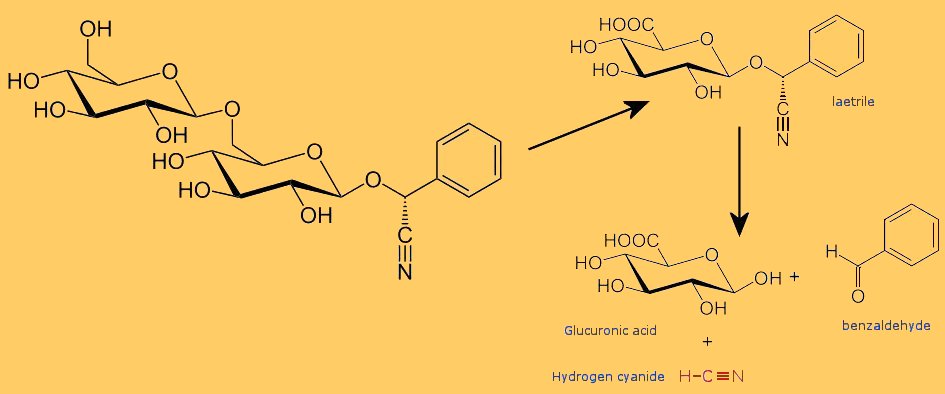
Hydrolysis reactions of amygdalin
If it's so poisonous, why is it present in plants and seeds?
As a defence mechanism against insects or animals that might want to eat the plant. Very often the plant will have the amygdalin (or a similar cyanide-containing molecule) stored in a separate compartment from the enzyme that activates it. Only when the plant is damaged, such as when it is eaten, do the contents of both compartments mix, releasing the cyanide and poisoning the animal. The idea is not to kill the animal, but to make its dining experience unpleasant enough that it remembers never to eat that same plant again. In the case of seeds and kernels, the plant wants the animal to eat the fleshy fruit, but not the seeds. The plant wants these to be discarded uneaten or to be swallowed whole, so they can pass through the digestive system intact and be distributed in the animal's droppings. This is why some cyanide-containing seeds (like apple pips) are reasonably safe to eat whole, so long as you don't chew them up with your teeth and release the stored amygdalin.
How much is needed to be harmful?
Studies indicate 0.5-3.5 mg of cyanide per kg of body weight can be lethal. Therefore, based on the amounts of amygdalin typically present in raw apricot kernels, it is estimated that adults could ingest only three small apricot kernels (370 mg), before seeing harmful effects. And for toddlers the amount would be much smaller – only 60 mg, which is about a half of a small kernel.
So if we don’t eat apricot kernels, then no harm done, right?
Not quite, because that’s not the end of the story. The problem is that from the mid 1970s amygdalin started to be promoted as a cure for various forms of cancer, and was sold under the name Laetrile which was a contraction of L-mandelonitrile (the hydrolysed version of amygdalin).
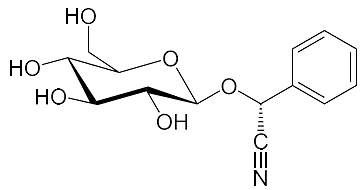
Laetrile (L-mandelonitrile)
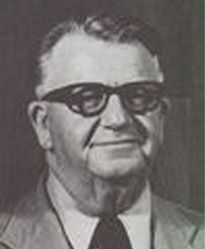 The main proponent of this ‘remedy’ was the American Ernst Krebs Jr (photo, right), whose father had reported the alleged anticancer effects in rodents in the 1920s. Despite no evidence for its effectiveness, and no proper clinical trials, sales of laetrile started to take off, partly because people were desperate for any hope of a cure, but also because it was marketed as being a ‘natural’ product, coming from apricots. The remarkable success of the sales of laetrile came about partly due to two myths propounded by Krebs Jr. In 1970, he announced (without evidence) that he had discovered that the cause of all cancers was a lack of a certain vitamin (in similar way to scurvy is a deficiency of vitamin C, or rickets of vitamin D). He said that the missing vitamin was actually amygdalin, and named it as ‘vitamin B17’, and by doing so plugged straight into the American public’s infatuation with vitamin supplements.
The main proponent of this ‘remedy’ was the American Ernst Krebs Jr (photo, right), whose father had reported the alleged anticancer effects in rodents in the 1920s. Despite no evidence for its effectiveness, and no proper clinical trials, sales of laetrile started to take off, partly because people were desperate for any hope of a cure, but also because it was marketed as being a ‘natural’ product, coming from apricots. The remarkable success of the sales of laetrile came about partly due to two myths propounded by Krebs Jr. In 1970, he announced (without evidence) that he had discovered that the cause of all cancers was a lack of a certain vitamin (in similar way to scurvy is a deficiency of vitamin C, or rickets of vitamin D). He said that the missing vitamin was actually amygdalin, and named it as ‘vitamin B17’, and by doing so plugged straight into the American public’s infatuation with vitamin supplements.
And is it a vitamin?
No, of course not. Krebs called it this to try to circumvent the strict screening required for new drugs. But that doesn’t stop it being advertised as such even to this day.
So what was the other myth?
Arguably the more dangerous myth Krebs Jr created was that laetrile was perfectly safe, in contrast to conventional ‘non-natural’ cancer remedies. This is potentially deadly, because amygdalin contains about 6% cyanide by weight, which means that a single 500 mg laetrile pill contains a potentially lethal dose if ingested orally. Indeed, medical trials on dogs showed laetrile to be toxic, and many patients who were treated with laetrile in a ‘border clinic’ in Mexico also suffered toxic effects. There were also a number of cases of patient deaths directly linked to laetrile consumption.
So what happened?
In the 1970s, after it failed to prove effective against any form of cancer in multiple scientific tests, the US FDA refused to give it a medical license, and began to restrict access to it.
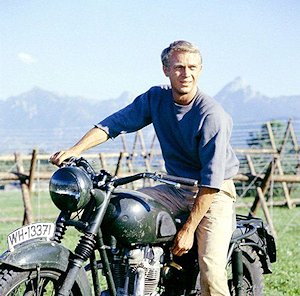 So that was the end of it?
So that was the end of it?
Unfortunately no. Advocates for its use suggested that there was a conspiracy between the FDA, the medical community, and ‘Big Pharma’ to prevent people from having access to this ‘cheap, painless remedy’, and force them to use the more expensive commercial drugs instead. They said this was exploiting the American people, and cancer patients specifically, who had the right to choose what medicine to take. Even celebrities such as the actor Steve McQueen was taken in by the hype. He travelled to Mexico to get laetrile as part of a course of alternative therapies to treat his lung cancer. Needless to say the treatment failed and McQueen died shortly afterwards.
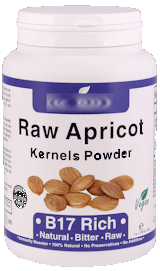 Despite the lack of evidence that it worked, and the mounting evidence that it was actually dangerous, in the 1970s many States challenged the FDA in court saying they had no right to restrict the sales of a 'potentially life-saving drug'. Unbelievably they won, passing laws making laetrile legal in over 25 States. However, the FDA didn’t give in, as it is still illegal to transport laetrile across State lines, and vendors are still prosecuted for marketing it as a cancer treatment.
Despite the lack of evidence that it worked, and the mounting evidence that it was actually dangerous, in the 1970s many States challenged the FDA in court saying they had no right to restrict the sales of a 'potentially life-saving drug'. Unbelievably they won, passing laws making laetrile legal in over 25 States. However, the FDA didn’t give in, as it is still illegal to transport laetrile across State lines, and vendors are still prosecuted for marketing it as a cancer treatment.
Is it still available?
Amazingly it is still available in some States and in many counties, and on the internet, of course, and sold as part of a ‘holistic nutritional regime’ or for treating cancer pain – none of which have any evidence to back up the claims. Gradually, though, it is being recognised as ‘fake news’, and has been described as ‘a canonical example of quackery’. The FDA call it “a highly toxic product that has not shown any effect on treating cancer”, while Irving Lerner (University of Minnesota) called it “unquestionably the slickest, most sophisticated, and certainly the most remunerative cancer quack promotion in medical history.”

Bibliography
Cancer studies
- N.M. Ellison, D.P. Byar, G.R. Newell, New Engl. J. of Med. 299 (1978) 549–52.
- C.G. Moertel, M.M. Ames, J.S. Kovach, T.P Moyer, et al. J. Am. Med. Assoc. 245 (1981) 591–4.
- C.G. Moertel, T.R. Fleming, J. Rubin, L.K. Kvols, et al. New Engl. J. of Med. 306 (1982) 201–6.
- C.C. Stock, G.S. Tarnowski, F.A. Schmid, D.J. Hutchison, M.N. Teller, . "Antitumor tests of amygdalin in transplantable animal tumor systems". J. Surg. Oncol. 10 (1978) 81–8.
- C.C. Stock, D.S. Martin, K. Sugiura K, J. Surg. Oncol. 10 (1978) 89–123.
Poison effects
- European Food Safety Authority (cyanide poison dosage from apricot kernels)
- B. O'Brien, C. Quigg, T. Leong, Eur. J. Emerg. Med. 12 (2005) 257–8.
- M. Zagrobelny, S. Bak, B.L. Møller, Phytochem. 69 (2008) 1457–1468. (Cyanide use in plants)
Controversy
- I.J. Lerner, "Laetrile: a lesson in cancer quackery". CA Cancer J. Clin. 31 (1981) 91–5.
- V. Herbert, Am. J. Clin. Nutr. 32 (1979) 1121–58
- I.J. Lerner, Cancer 53 (S3) (1984) 815–9.
- S.L. Nightingale, Pub. Health Rep. 99 (1984) 333–8.
- J.C. Petersen, G.E. Markle, Soc. Stud. of Sci. 9 (1979) 139–66.
Miscellaneous


 Back to Molecule of the Month page. [DOI:10.6084/m9.figshare.5577970]
Back to Molecule of the Month page. [DOI:10.6084/m9.figshare.5577970]

![]()
![]()
![]()
![]()





 The main proponent of this ‘remedy’ was the American Ernst Krebs Jr (photo, right), whose father had reported the alleged anticancer effects in rodents in the 1920s. Despite no evidence for its effectiveness, and no proper clinical trials, sales of laetrile started to take off, partly because people were desperate for any hope of a cure, but also because it was marketed as being a ‘natural’ product, coming from apricots. The remarkable success of the sales of laetrile came about partly due to two myths propounded by Krebs Jr. In 1970, he announced (without evidence) that he had discovered that the cause of all cancers was a lack of a certain vitamin (in similar way to scurvy is a deficiency of
The main proponent of this ‘remedy’ was the American Ernst Krebs Jr (photo, right), whose father had reported the alleged anticancer effects in rodents in the 1920s. Despite no evidence for its effectiveness, and no proper clinical trials, sales of laetrile started to take off, partly because people were desperate for any hope of a cure, but also because it was marketed as being a ‘natural’ product, coming from apricots. The remarkable success of the sales of laetrile came about partly due to two myths propounded by Krebs Jr. In 1970, he announced (without evidence) that he had discovered that the cause of all cancers was a lack of a certain vitamin (in similar way to scurvy is a deficiency of  So that was the end of it?
So that was the end of it? Despite the lack of evidence that it worked, and the mounting evidence that it was actually dangerous, in the 1970s many States challenged the FDA in court saying they had no right to restrict the sales of a 'potentially life-saving drug'. Unbelievably they won, passing laws making laetrile legal in over 25 States. However, the FDA didn’t give in, as it is still illegal to transport laetrile across State lines, and vendors are still prosecuted for marketing it as a cancer treatment.
Despite the lack of evidence that it worked, and the mounting evidence that it was actually dangerous, in the 1970s many States challenged the FDA in court saying they had no right to restrict the sales of a 'potentially life-saving drug'. Unbelievably they won, passing laws making laetrile legal in over 25 States. However, the FDA didn’t give in, as it is still illegal to transport laetrile across State lines, and vendors are still prosecuted for marketing it as a cancer treatment.